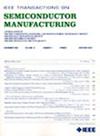Geometry-Based Curvilinear Mask Process Correction for Enhanced Pattern Fidelity, Contrast, and Manufacturability
IF 2.3
3区 工程技术
Q2 ENGINEERING, ELECTRICAL & ELECTRONIC
引用次数: 0
Abstract
Curvilinear (CL) mask patterns, essential for extreme ultraviolet lithography in advanced semiconductor manufacturing, suffer from degraded fidelity and contrast due to complex pattern environments and severe proximity effects, necessitating CL mask process correction (CL-MPC). However, conventional shape-based CL-MPC methods cannot enhance image contrast because of their inability to adjust dose levels, while dose-based methods require extensive computational time and are incompatible with electron beam writers lacking dose adjustment capabilities. Therefore, this study proposes a two-layer geometry-based CL-MPC method integrating pattern fidelity and image contrast co-optimization with pattern manufacturability enhancement. It employs two overlapping patterns, each of which adjusts the geometry without modifying the dose. A skeleton-based approach creates CL pattern fragments, and dual proportional-integral–derivative controllers improve the pattern fidelity more effectively by classifying the energy slope of target points. For image contrast improvement, a feedback mechanism replaces unsatisfactory parameters with optimized values by minimizing the reciprocal of the energy slope of target points. The pattern manufacturability enhancement further improves mask fabrication by smoothing edge corners and optimizing pattern angles. The proposed method significantly improves pattern fidelity, image contrast, correction runtime efficiency, and manufacturability, making corrected patterns compatible with all electron-beam writers and presenting a promising solution for CL-MPC limitations.基于几何的曲线掩模工艺校正,增强图案保真度、对比度和可制造性
曲线(CL)掩模模式是先进半导体制造中极紫外光刻技术所必需的,由于复杂的模式环境和严重的接近效应,其保真度和对比度会下降,因此需要CL掩模工艺校正(CL- mpc)。然而,传统的基于形状的CL-MPC方法不能增强图像对比度,因为它们不能调节剂量水平,而基于剂量的方法需要大量的计算时间,并且与缺乏剂量调节能力的电子束书写器不兼容。因此,本研究提出了一种基于两层几何的CL-MPC方法,该方法将图案保真度和图像对比度协同优化与图案可制造性增强相结合。它采用两种重叠的模式,每一种模式在不改变剂量的情况下调整几何形状。基于骨架的方法生成CL模式片段,对偶比例-积分-导数控制器通过对目标点的能量斜率进行分类,更有效地提高了模式保真度。为了提高图像对比度,反馈机制通过最小化目标点能量斜率的倒数,将不满意的参数替换为优化值。图案可制造性的增强通过平滑边缘和优化图案角度进一步改善了掩模的制造。该方法显著提高了模式保真度、图像对比度、校正运行时效率和可制造性,使校正模式与所有电子束写入器兼容,并为CL-MPC限制提供了一个有希望的解决方案。
本文章由计算机程序翻译,如有差异,请以英文原文为准。
求助全文
约1分钟内获得全文
求助全文
来源期刊

IEEE Transactions on Semiconductor Manufacturing
工程技术-工程:电子与电气
CiteScore
5.20
自引率
11.10%
发文量
101
审稿时长
3.3 months
期刊介绍:
The IEEE Transactions on Semiconductor Manufacturing addresses the challenging problems of manufacturing complex microelectronic components, especially very large scale integrated circuits (VLSI). Manufacturing these products requires precision micropatterning, precise control of materials properties, ultraclean work environments, and complex interactions of chemical, physical, electrical and mechanical processes.
 求助内容:
求助内容: 应助结果提醒方式:
应助结果提醒方式:


